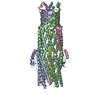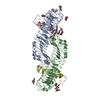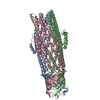+ Open data
Open data
- Basic information
Basic information
| Entry | Database: PDB / ID: 6wxi | ||||||||||||
|---|---|---|---|---|---|---|---|---|---|---|---|---|---|
| Title | Colicin E1 fragment in nanodisc-embedded TolC | ||||||||||||
 Components Components | Outer membrane protein TolC | ||||||||||||
 Keywords Keywords |  TRANSPORT PROTEIN / antibiotic efflux / TRANSPORT PROTEIN / antibiotic efflux /  bacteriocin bacteriocin | ||||||||||||
| Function / homology |  Function and homology information Function and homology informationMacAB-TolC complex / enterobactin transport / bile acid transmembrane transporter activity / xenobiotic detoxification by transmembrane export across the cell outer membrane /  efflux pump complex / periplasmic side of plasma membrane / xenobiotic detoxification by transmembrane export across the plasma membrane / bile acid and bile salt transport / efflux pump complex / periplasmic side of plasma membrane / xenobiotic detoxification by transmembrane export across the plasma membrane / bile acid and bile salt transport /  porin activity / efflux transmembrane transporter activity ...MacAB-TolC complex / enterobactin transport / bile acid transmembrane transporter activity / xenobiotic detoxification by transmembrane export across the cell outer membrane / porin activity / efflux transmembrane transporter activity ...MacAB-TolC complex / enterobactin transport / bile acid transmembrane transporter activity / xenobiotic detoxification by transmembrane export across the cell outer membrane /  efflux pump complex / periplasmic side of plasma membrane / xenobiotic detoxification by transmembrane export across the plasma membrane / bile acid and bile salt transport / efflux pump complex / periplasmic side of plasma membrane / xenobiotic detoxification by transmembrane export across the plasma membrane / bile acid and bile salt transport /  porin activity / efflux transmembrane transporter activity / monoatomic ion transmembrane transport / cell outer membrane / response to organic cyclic compound / response to toxic substance / monoatomic ion channel activity / outer membrane-bounded periplasmic space / response to xenobiotic stimulus / response to antibiotic / porin activity / efflux transmembrane transporter activity / monoatomic ion transmembrane transport / cell outer membrane / response to organic cyclic compound / response to toxic substance / monoatomic ion channel activity / outer membrane-bounded periplasmic space / response to xenobiotic stimulus / response to antibiotic /  membrane / identical protein binding membrane / identical protein bindingSimilarity search - Function | ||||||||||||
| Biological species |   Escherichia coli (E. coli) Escherichia coli (E. coli) | ||||||||||||
| Method |  ELECTRON MICROSCOPY / ELECTRON MICROSCOPY /  single particle reconstruction / single particle reconstruction /  cryo EM / Resolution: 2.84 Å cryo EM / Resolution: 2.84 Å | ||||||||||||
 Authors Authors | Kaelber, J.T. / Budiardjo, S.J. / Firlar, E. / Ikujuni, A.P. / Slusky, J.S.G. | ||||||||||||
| Funding support |  United States, 3items United States, 3items
| ||||||||||||
 Citation Citation |  Journal: Elife / Year: 2022 Journal: Elife / Year: 2022Title: Colicin E1 opens its hinge to plug TolC. Authors: S Jimmy Budiardjo / Jacqueline J Stevens / Anna L Calkins / Ayotunde P Ikujuni / Virangika K Wimalasena / Emre Firlar / David A Case / Julie S Biteen / Jason T Kaelber / Joanna S G Slusky /  Abstract: The double membrane architecture of Gram-negative bacteria forms a barrier that is impermeable to most extracellular threats. Bacteriocin proteins evolved to exploit the accessible, surface-exposed ...The double membrane architecture of Gram-negative bacteria forms a barrier that is impermeable to most extracellular threats. Bacteriocin proteins evolved to exploit the accessible, surface-exposed proteins embedded in the outer membrane to deliver cytotoxic cargo. Colicin E1 is a bacteriocin produced by, and lethal to, that hijacks the outer membrane proteins (OMPs) TolC and BtuB to enter the cell. Here, we capture the colicin E1 translocation domain inside its membrane receptor, TolC, by high-resolution cryo-electron microscopy to obtain the first reported structure of a bacteriocin bound to TolC. Colicin E1 binds stably to TolC as an open hinge through the TolC pore-an architectural rearrangement from colicin E1's unbound conformation. This binding is stable in live cells as indicated by single-molecule fluorescence microscopy. Finally, colicin E1 fragments binding to TolC plug the channel, inhibiting its native efflux function as an antibiotic efflux pump, and heightening susceptibility to three antibiotic classes. In addition to demonstrating that these protein fragments are useful starting points for developing novel antibiotic potentiators, this method could be expanded to other colicins to inhibit other OMP functions. | ||||||||||||
| History |
|
- Structure visualization
Structure visualization
| Movie |
 Movie viewer Movie viewer |
|---|---|
| Structure viewer | Molecule:  Molmil Molmil Jmol/JSmol Jmol/JSmol |
- Downloads & links
Downloads & links
- Download
Download
| PDBx/mmCIF format |  6wxi.cif.gz 6wxi.cif.gz | 247.6 KB | Display |  PDBx/mmCIF format PDBx/mmCIF format |
|---|---|---|---|---|
| PDB format |  pdb6wxi.ent.gz pdb6wxi.ent.gz | 199.6 KB | Display |  PDB format PDB format |
| PDBx/mmJSON format |  6wxi.json.gz 6wxi.json.gz | Tree view |  PDBx/mmJSON format PDBx/mmJSON format | |
| Others |  Other downloads Other downloads |
-Validation report
| Arichive directory |  https://data.pdbj.org/pub/pdb/validation_reports/wx/6wxi https://data.pdbj.org/pub/pdb/validation_reports/wx/6wxi ftp://data.pdbj.org/pub/pdb/validation_reports/wx/6wxi ftp://data.pdbj.org/pub/pdb/validation_reports/wx/6wxi | HTTPS FTP |
|---|
-Related structure data
| Related structure data |  21960MC  6wxhC C: citing same article ( M: map data used to model this data |
|---|---|
| Similar structure data |
- Links
Links
- Assembly
Assembly
| Deposited unit | 
|
|---|---|
| 1 |
|
- Components
Components
| #1: Protein | Mass: 53783.355 Da / Num. of mol.: 3 Source method: isolated from a genetically manipulated source Source: (gene. exp.)   Escherichia coli (strain K12) (bacteria) Escherichia coli (strain K12) (bacteria)Strain: K12 Gene: tolC, colE1-i, mtcB, mukA, refI, toc, weeA, b3035, JW5503 Plasmid: pTrc99a / Production host:   Escherichia coli BL21(DE3) (bacteria) / Strain (production host): BL21(DE3) / References: UniProt: P02930 Escherichia coli BL21(DE3) (bacteria) / Strain (production host): BL21(DE3) / References: UniProt: P02930 |
|---|
-Experimental details
-Experiment
| Experiment | Method:  ELECTRON MICROSCOPY ELECTRON MICROSCOPY |
|---|---|
| EM experiment | Aggregation state: PARTICLE / 3D reconstruction method:  single particle reconstruction single particle reconstruction |
- Sample preparation
Sample preparation
| Component | Name: Outer membrane protein TolC / Type: COMPLEX / Entity ID: all / Source: RECOMBINANT | |||||||||||||||
|---|---|---|---|---|---|---|---|---|---|---|---|---|---|---|---|---|
| Molecular weight | Value: 0.053741 MDa / Experimental value: NO | |||||||||||||||
| Source (natural) | Organism:   Escherichia coli K-12 (bacteria) Escherichia coli K-12 (bacteria) | |||||||||||||||
| Source (recombinant) | Organism:   Escherichia coli BL21(DE3) (bacteria) / Plasmid Escherichia coli BL21(DE3) (bacteria) / Plasmid : pTrc99a : pTrc99a | |||||||||||||||
| Buffer solution | pH: 8 | |||||||||||||||
| Buffer component |
| |||||||||||||||
| Specimen | Conc.: 1 mg/ml / Embedding applied: NO / Shadowing applied: NO / Staining applied : NO / Vitrification applied : NO / Vitrification applied : YES : YES | |||||||||||||||
| Specimen support | Grid material: GOLD / Grid type: UltrAuFoil | |||||||||||||||
Vitrification | Instrument: FEI VITROBOT MARK IV / Cryogen name: ETHANE / Humidity: 100 % / Chamber temperature: 298 K |
- Electron microscopy imaging
Electron microscopy imaging
| Experimental equipment |  Model: Talos Arctica / Image courtesy: FEI Company |
|---|---|
| Microscopy | Model: FEI TALOS ARCTICA |
| Electron gun | Electron source : :  FIELD EMISSION GUN / Accelerating voltage: 200 kV / Illumination mode: FLOOD BEAM FIELD EMISSION GUN / Accelerating voltage: 200 kV / Illumination mode: FLOOD BEAM |
| Electron lens | Mode: BRIGHT FIELD Bright-field microscopy / Nominal magnification: 130000 X / Calibrated defocus min: 478 nm / Calibrated defocus max: 2593 nm / Cs Bright-field microscopy / Nominal magnification: 130000 X / Calibrated defocus min: 478 nm / Calibrated defocus max: 2593 nm / Cs : 2.7 mm / C2 aperture diameter: 50 µm / Alignment procedure: ZEMLIN TABLEAU : 2.7 mm / C2 aperture diameter: 50 µm / Alignment procedure: ZEMLIN TABLEAU |
| Specimen holder | Cryogen: NITROGEN / Specimen holder model: FEI TITAN KRIOS AUTOGRID HOLDER |
| Image recording | Average exposure time: 8 sec. / Electron dose: 33.04 e/Å2 / Detector mode: COUNTING / Film or detector model: GATAN K2 SUMMIT (4k x 4k) / Num. of grids imaged: 1 / Num. of real images: 16443 / Details: 5 frames per second |
| EM imaging optics | Energyfilter name : GIF Quantum LS / Energyfilter slit width: 20 eV : GIF Quantum LS / Energyfilter slit width: 20 eV |
| Image scans | Width: 3838 / Height: 3710 / Movie frames/image: 40 |
- Processing
Processing
| EM software |
| ||||||||||||||||||||||||||||||||||||||||||||||||||||||||||||
|---|---|---|---|---|---|---|---|---|---|---|---|---|---|---|---|---|---|---|---|---|---|---|---|---|---|---|---|---|---|---|---|---|---|---|---|---|---|---|---|---|---|---|---|---|---|---|---|---|---|---|---|---|---|---|---|---|---|---|---|---|---|
CTF correction | Type: PHASE FLIPPING AND AMPLITUDE CORRECTION | ||||||||||||||||||||||||||||||||||||||||||||||||||||||||||||
| Particle selection | Num. of particles selected: 2092678 | ||||||||||||||||||||||||||||||||||||||||||||||||||||||||||||
| Symmetry | Point symmetry : C3 (3 fold cyclic : C3 (3 fold cyclic ) ) | ||||||||||||||||||||||||||||||||||||||||||||||||||||||||||||
3D reconstruction | Resolution: 2.84 Å / Resolution method: FSC 0.143 CUT-OFF / Num. of particles: 196158 / Algorithm: FOURIER SPACE / Num. of class averages: 17 / Symmetry type: POINT | ||||||||||||||||||||||||||||||||||||||||||||||||||||||||||||
| Atomic model building | Protocol: OTHER / Space: REAL | ||||||||||||||||||||||||||||||||||||||||||||||||||||||||||||
| Atomic model building | PDB-ID: 6WXH Accession code: 6WXH / Source name: PDB / Type: experimental model |
 Movie
Movie Controller
Controller














 PDBj
PDBj
